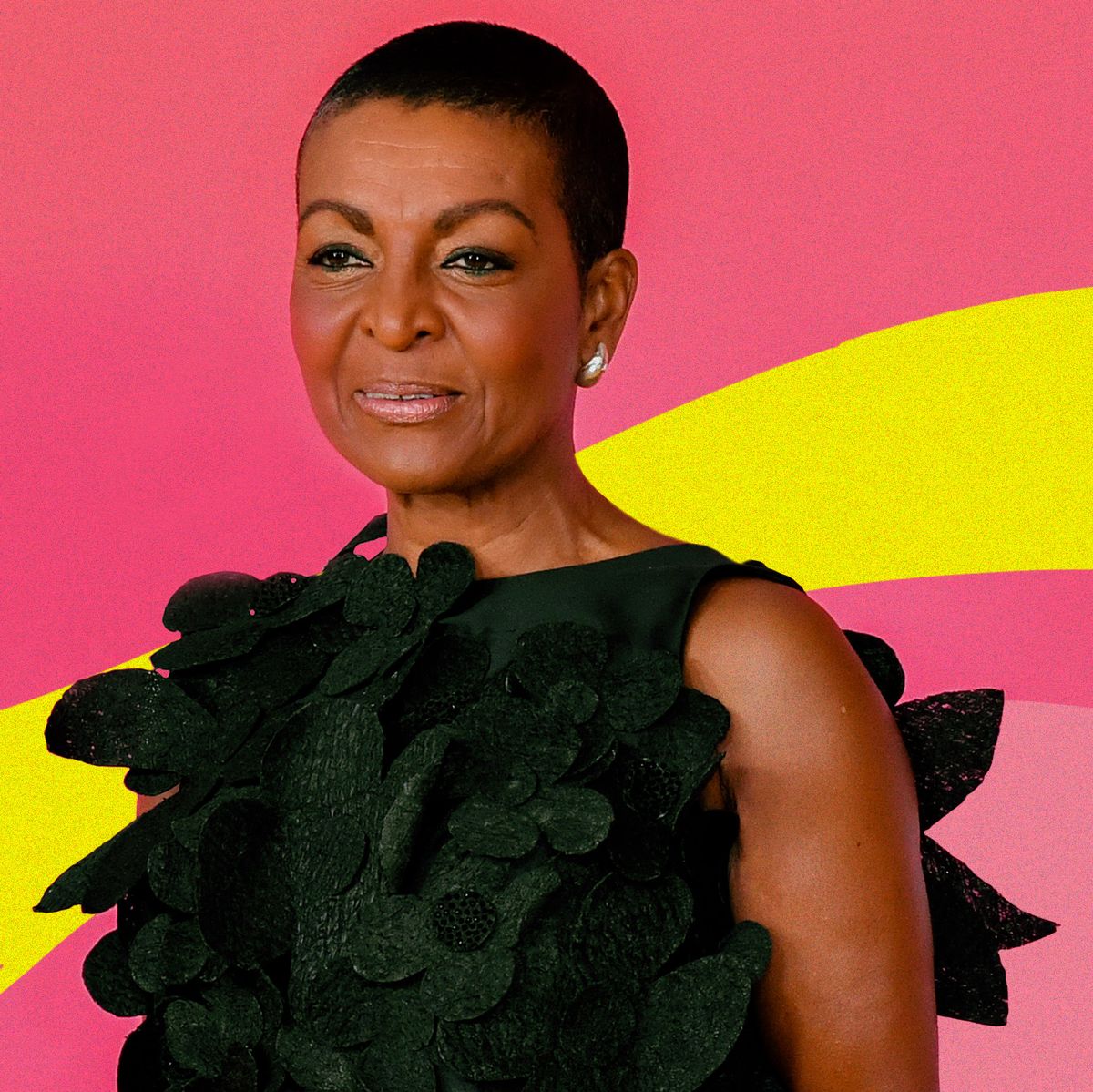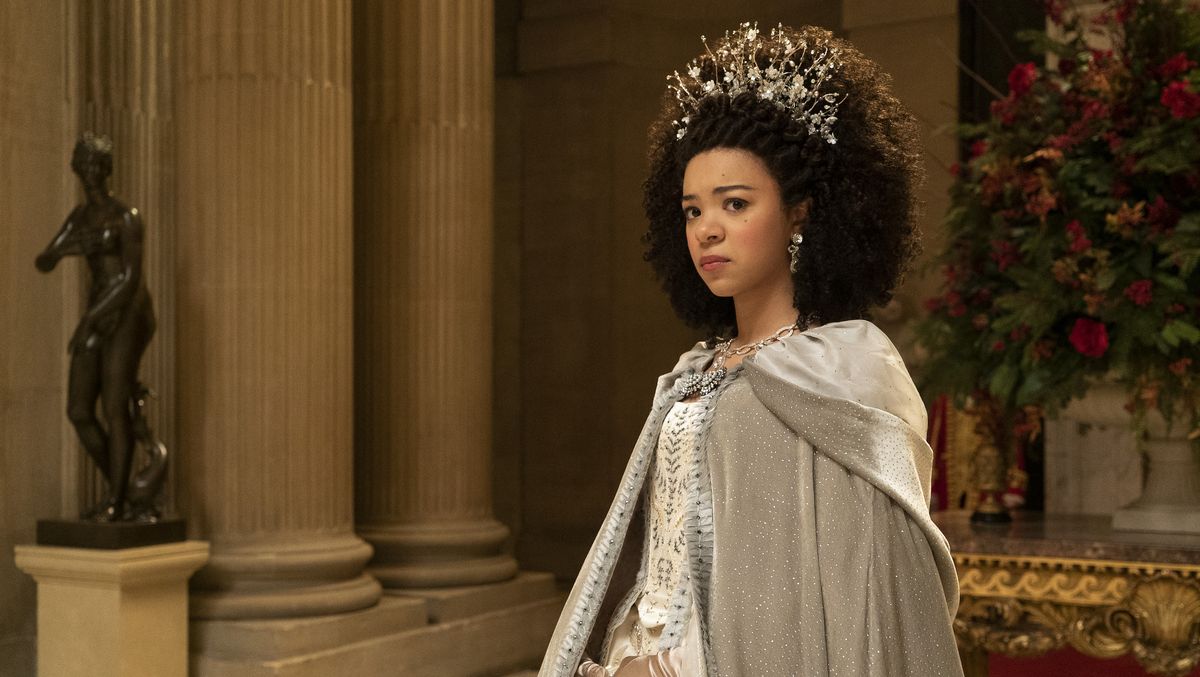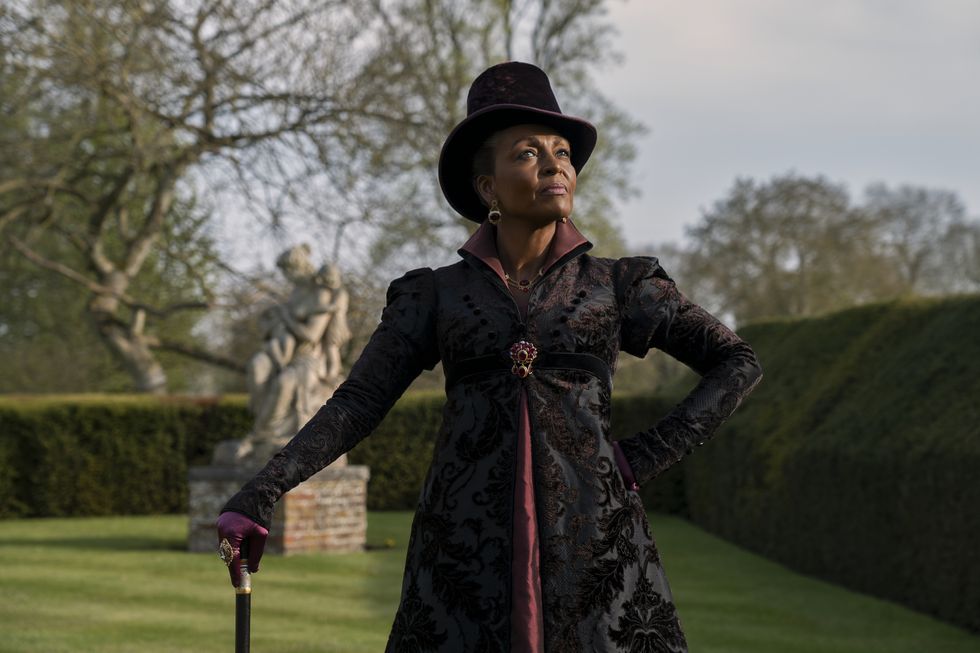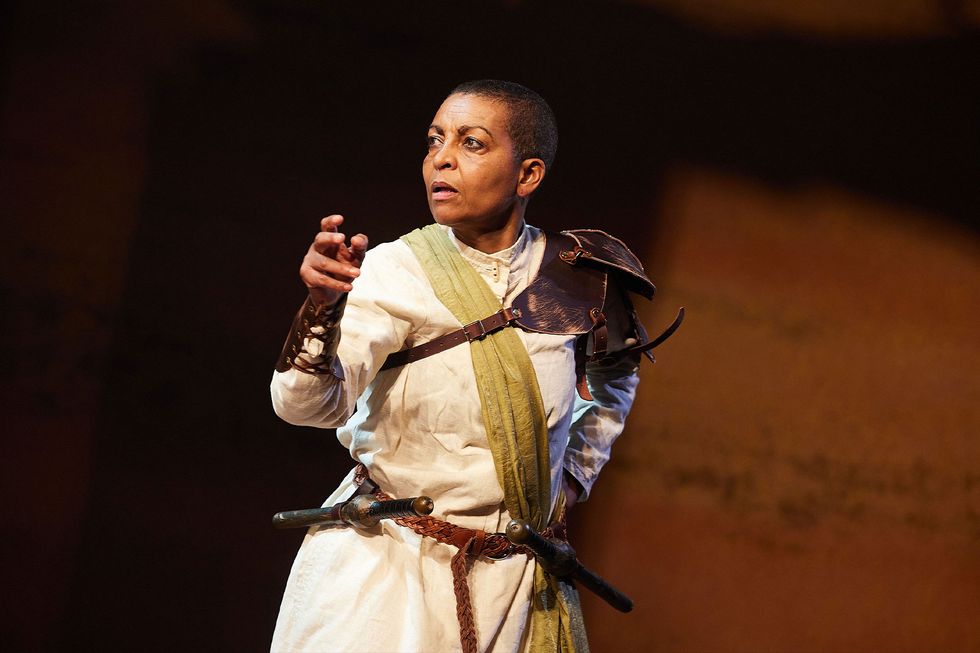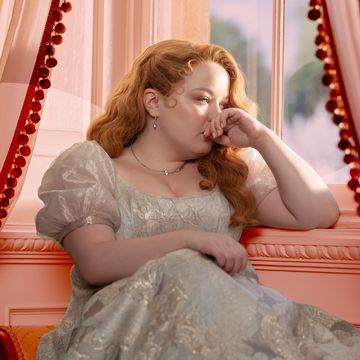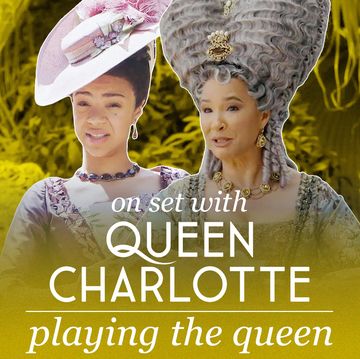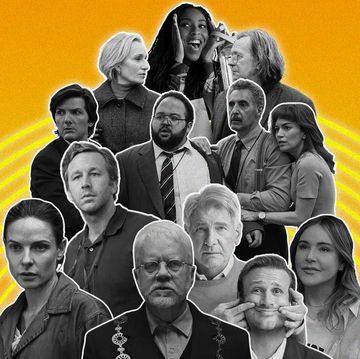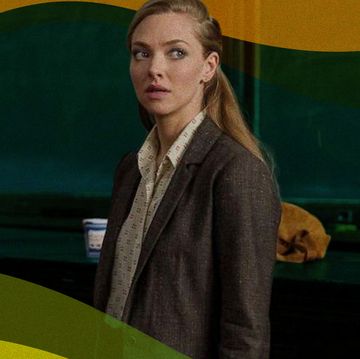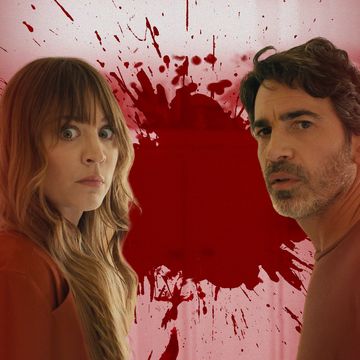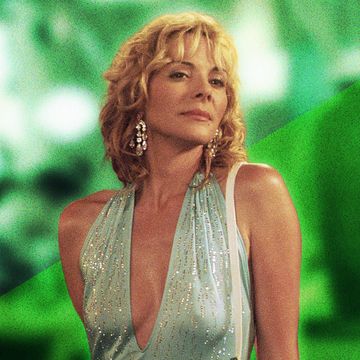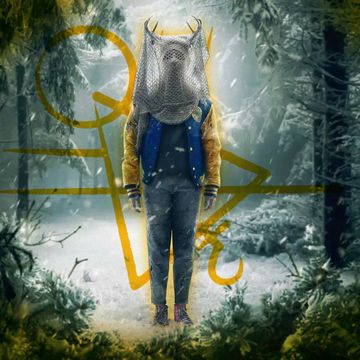Looking back, British actress Adjoa Andoh found her 20s to be “absolutely gut-churning.” She was constantly trying to please people, constantly looking for approval, and always wondering if reactions she spurred in others meant she was funny or pretty or talented. It’s a common place in which many young adults find themselves, and it’s oftentimes excruciating and exhausting. But Andoh — who moved to London in the 1980s to pursue her dream of becoming an actress when no one she knew had done anything like that — felt that it was a sink-or-swim situation.
“Maybe it’s because of where I grew up,” says Andoh, 60, referencing her childhood in the white, upper-middle-class enclave of the Cotswolds, about 90 miles west of London. “We were so visible, me, my dad, and my brother — we were the only Black people [in our village]. You have to learn to fight people, you have to learn to charm people, you have to learn to entertain people. It doesn’t matter if you’re shy or you find social situations difficult — you don’t have the choice to be that person. So, you have to become very front-footed. And it’s exhausting.”
Now, though, with a 30-year career full of lead stage roles, international film roles, British and American television roles, BBC radio acting, more than 150 audiobook narrations, and an honorary fellowship from the Royal Society of Literature, Andoh has finally gotten to a place where none of that bothers her anymore. And it’s in her role as Lady Agatha Danbury in Bridgerton and Shondaland’s new prequel series, Queen Charlotte: A Bridgerton Story, now streaming on Netflix, where she has found myriad parallels to her own current stage of life.
“There is a really strong conversation that goes with Lady Danbury, her saying, ‘I find my body acceptable, and I will make my place in the world,’” says Andoh. “And I feel like there’s a through line [in my work]. It’s a cross-fertilization that goes backwards and forwards between Lady Danbury on the page, Lady Danbury on the screen, Lady Danbury in my heart, Lady Danbury in other aspects of my work, and other aspects of my work in Lady Danbury, in my politics, and in my sense of growing freedom that I feel [to be myself]. And it’s all really fantastic.”
Andoh’s Danbury jumped from the screen when audiences were introduced to her fierce but fair countenance in the first season of Bridgerton three years ago. Over the show’s first two seasons, we’ve seen Danbury’s cunning and determination help shape the world of the ton, and we’ve seen her empathy and generosity help shape the people in it. In Queen Charlotte, which recounts the rise of the young queen alongside her husband, young King George, creator and executive producer Shonda Rhimes intertwines the origin story of young Agatha Danbury, played by Arsema Thomas. In doing so, the Lady Danbury we thought we knew is revealed in an incredibly deep way, bringing an understanding to this complex woman and her raison d’être. What’s more, Danbury’s relationship with Lady Bridgerton (Ruth Gemmell) is further fleshed out, showing that women in their 50s and 60s require passion, touch, and companionship (including platonic) just as much as any insecure 20-something.
“[Having Agatha’s story grow deeper for the audience] has been pretty magnificent, actually,” says Andoh. “Bridgerton has been a game changer. It means that [historical dramas] will never, ever be the same again. So, it’s all been utterly transformative.”
Before achieving global acclaim as Lady Danbury, a role that saw Andoh nominated for a 2021 and 2023 NAACP Image Award, Andoh grew up with her brother, her history teacher mother, who was originally from the north of England, and her Ghanaian-born father, who worked at British Aerospace. Drama wasn’t seen as a proper subject and certainly not a career aspiration, so Andoh studied literature, which allowed her to be in all the school plays. With that, and her keen entrepreneurial spirit and a desire to perform, Andoh, from a very young age, was running a theater out of her living room.
“I would direct my friends, and I would choreograph them to Stravinsky’s The Rite of Spring or Holst’s Planets suite,” Andoh says. “Or I would direct plays. I think we did [Noël Coward’s] Blithe Spirit. I’d never seen Blithe Spirit. I didn’t really know the story, but there was a lot of light switches going on and off and net curtains, and all our parents had to pay money to sit through interminable hours of screaming children.”
She continues, “I loved reading books, and I loved telling stories. I was always dressing up with my friends. You would see me in the late 1960s in a pair of clogs and red tights on my head, and a big peasant skirt, trolling up and down my little village.”
As much as she loved performing, Andoh couldn’t see a professional route to it, and even so, her path seemed laid out for her: get into Cambridge, graduate with a degree in law, become a lawyer. But when she was about 18, she had a nervous breakdown and tanked her A levels (similar to the SATs). She didn’t get into Cambridge and instead went to work in a bank, where she was bored and, admittedly, bad at her job. After a year, she acquiesced to obtaining her law degree in Bristol but mostly just to escape the bank. It was in her second year there that she joined a Black women’s group and met Debora Kotto, the sister of Yaphet Kotto, the first Black villain in a James Bond film. Debora was a trained actor in her own right and was running drama classes, to which she invited Andoh.
“I tried to be a good African daughter, but I wasn’t any good at it,” says Andoh. “And by now, I sort of got a sniff of the possibility at another life.”
Andoh auditioned for and was cast in a play written by and starring Kotto and directed by Sallie Aprahamian, whom Andoh is still close with today and who would eventually get Andoh her first TV job on EastEnders. The play was a five-actor show about Black women, and they opened in London playing small community venues around the city. Andoh was hooked, and she never returned to Bristol, making Brixton in South London her new home as she tried to make a go of her dream.
“I learned how to lay concrete floors and build windows and doors and didn’t work [as an actress] for a year,” she says of those early days in the big city. “I cleaned a lot of toilets, modeled for a lot of life drawing classes. And then slowly, other Black actresses told me about auditions. I’ve never forgotten the generosity of that — to put me in competition with them didn’t benefit them in any way apart from being kind.”
Eventually, Andoh landed a job with Theatre Centre, a feminist, socialist, young people’s touring company, and was put on an equity contract. That same week, she found out she was pregnant. She was 22 years old.
“I had to call them up and say, ‘I really want this, but I’m pregnant,’” she recalls. “There was a pause, and then the administrator said, ‘Right, well, we’ll have to institute a maternity policy then, won’t we?’ And I worked for that company until I was eight-and-a-half months pregnant. I played three characters, and my 11-year-old boy character just got fatter and leaned forward a bit more [laughs]. And we were constantly having to buy me new trousers as I expanded. But I was 22, 23; I was fit as a butcher’s dog!”
Since then, Andoh has starred in productions at the Royal Shakespeare Company and the National Theatre, including as Condoleezza Rice in Stuff Happens, and Serafina Pekkala in His Dark Materials, among others. In 2019, she co-directed Richard II and played the fatally flawed king at Shakespeare’s Globe Theatre in the U.K.’s first all-women-of-color production. And now, she’s directing and starring as another King Richard in Liverpool’s Playhouse Theatre production of Richard III, where she is the only Black person in an all-white cast.
“I fell in love with this play when I was a kid because of that sense that people were mean to Richard because of what he looked like,” says Andoh, referencing the play’s central plot surrounding the king’s deformity. “And I really resonated with the sense of unfairness of that. I don’t think I’ve ever lost that sense.”
With Richard II, Andoh sought to create a conversation around Brexit and to focus on the many and varied people of her country whose contributions to the nation’s wealth go back centuries. With Richard III, Andoh is hoping to stir ideas around the way a body can be pathologized when it has nothing to do with the content of character.
“I want to say to all those people who do not get a fair shake of the dice that it has nothing to do with who they are as a human being, and everything to do with the societal prejudices around them,” says Andoh. “With this play, I want to say, ‘I see you. I acknowledge you. I am with you.’”
These considered analyses into character and interpretation of story have always been Andoh’s method of understanding her art and craft. Politics intertwine with her career seamlessly, and Lady Danbury is no exception.
“When an African American male security guard in Atlanta gives me the full courtesy when I go into a building — job done,” says Andoh. “And if [being a part of the Bridgerverse] gets me into rooms and in conversations that I wasn’t necessarily in a position to do before, then that is gravy on my pie.”
At this point in her career, Andoh aims to be free to make “creative choices, artistic choices, rest and recreation choices, and storytelling choices that please me,” she says. “Oh, God, I sound like a hippie, but I want to live in the miracle of every day for the rest of the life that I have afforded to me.”
Valentina Valentini is a London-based entertainment, travel, and food writer and is also a senior contributor to Shondaland. Elsewhere, she has written for Vanity Fair, Vulture, Variety, Thrillist, Heated, and The Washington Post. Her personal essays can be read in the Los Angeles Times and Longreads, and her tangents and general complaints can be seen on Instagram at @ByValentinaV.
Get Shondaland directly in your inbox: SUBSCRIBE TODAY
